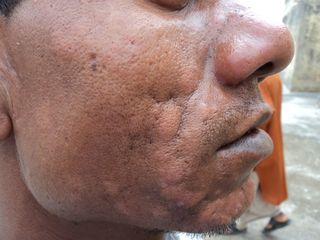PLOS Neglected Tropical Diseases ( IF 3.4 ) Pub Date : 2017-11-16 , DOI: 10.1371/journal.pntd.0005877 Eduard E Zijlstra 1, 2 , Fabiana Alves 1 , Suman Rijal 3 , Byron Arana 1 , Jorge Alvar 1

|
Background
The South-East Asia Region Kala-azar Elimination Programme (KAEP) is expected to enter the consolidation phase in 2017, which focuses on case detection, vector control, and identifying potential sources of infection. Post-kala-azar dermal leishmaniasis (PKDL) is thought to play a role in the recurrence of visceral leishmaniasis (VL)/kala-azar outbreaks, and control of PKDL is among the priorities of the KAEP.
Methodology and principal finding
We reviewed the literature with regard to PKDL in Asia and interpreted the findings in relation to current intervention methods in the KAEP in order to make recommendations. There is a considerable knowledge gap regarding the pathophysiology of VL and PKDL, especially the underlying immune responses. Risk factors (of which previous VL treatments may be most important) are poorly understood and need to be better defined. The role of PKDL patients in transmission is largely unknown, and there is insufficient information about the importance of duration, distribution and severity of the rash, time of onset, and self-healing. Current intervention methods focus on active case detection and treatment of all PKDL cases with miltefosine while there is increasing drug resistance. The prevention of PKDL by improved VL treatment currently receives insufficient attention.
Conclusion and significance
PKDL is a heterogeneous and dynamic condition, and patients differ with regard to time of onset after VL, chronicity, and distribution and appearance of the rash, as well as immune responses (including tendency to self-heal), all of which may vary over time. It is essential to fully describe the pathophysiology in order to make informed decisions on the most cost-effective approach. Emphasis should be on early detection of those who contribute to transmission and those who are in need of treatment, for whom short-course, effective, and safe drug regimens should be available. The prevention of PKDL should be emphasised by innovative and improved treatment for VL, which may include immunomodulation.
中文翻译:

印度次大陆的黑热病后皮肤利什曼病:对东南亚地区黑热病消除计划的威胁。
背景
东南亚地区黑热病消除计划(KAEP)预计将在 2017 年进入巩固阶段,重点是病例检测、病媒控制和识别潜在感染源。黑热病后皮肤利什曼病 (PKDL) 被认为在内脏利什曼病 (VL)/黑热病暴发的复发中起作用,控制 PKDL 是 KAEP 的优先事项之一。
方法和主要发现
我们回顾了亚洲有关 PKDL 的文献,并解释了与 KAEP 中当前干预方法相关的结果,以便提出建议。关于 VL 和 PKDL 的病理生理学,尤其是潜在的免疫反应,存在相当大的知识差距。对风险因素(其中以前的 VL 治疗可能最重要)了解甚少,需要更好地定义。PKDL 患者在传播中的作用在很大程度上是未知的,关于皮疹持续时间、分布和严重程度、发病时间和自愈的重要性的信息不足。当前的干预方法侧重于积极发现病例并使用米替福新治疗所有 PKDL 病例,同时耐药性不断增加。
结论及意义
PKDL 是一种异质性和动态状态,患者在 VL 后的发病时间、慢性期、皮疹的分布和外观以及免疫反应(包括自愈倾向)方面存在差异,所有这些都可能在时间。为了对最具成本效益的方法做出明智的决定,必须充分描述病理生理学。重点应放在早期发现那些促成传播的人和需要治疗的人,为他们提供短期、有效和安全的药物治疗方案。应该通过创新和改进的 VL 治疗来强调 PKDL 的预防,其中可能包括免疫调节。











































 京公网安备 11010802027423号
京公网安备 11010802027423号